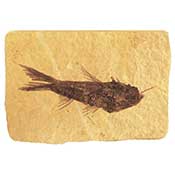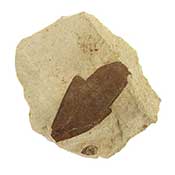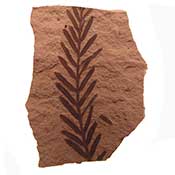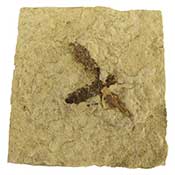Sign up for Lesson Plans, discounts & more!
The Tertiary Period:
The Age Of Mammals Begins
The Tertiary Period Is the old name given to the first period of the Cenozoic Era. It is no longer an official term and has been replaced by the Paleogene Period for the first 3 Epochs while the next 2 now belong to the Neogene Period. It may be a little confusing and why change the name anyway? Well the name Tertiary was first used in the mid 18th century. At that time all of geologic time was divided into only 3 periods, Primary, Secondary, and Tertiary. Later a fourth period was added not mysteriously called Quaternary.
A lot has been learned since that time and many divisions have been added to organize our understanding of geologic time. We now have Eons, Eras, Periods, and epochs. Each of those divisions have divisions. See the currently recognized Geologic Time Line. The old system using 4 time periods could no longer be helpful. Yet 2 of the old terms were still in use until recently, the Tertiary and the Quaternary. As of 2013 the Tertiary is gone. The Quaternary remains.
The remainder of this page details the Tertiary of old. For more current divisions see the links above: Paleogene Period, Neogene Period, and the Geologic Timeline.
The Tertiary Period began 65 million years ago and lasted more than 63 million years, until 1.8 million years ago. The Tertiary is made up of 5 epochs :
- The Paleocene Epoch - 65 to 54 million years ago
- The Eocene Epoch - 54 to 38 million years ago
- The Oligocene Epoch - 38 to 24 million years ago
- The Miocene Epoch - 24 to 5 million years ago
- The Pliocene Epoch- 5 to 1.8 million years ago
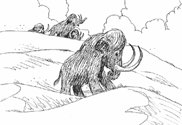
Each epoch has unique characteristics for climate and geography. The plants and animals changed from epoch to epoch also.
In the early 1800’s a system for naming geologic time labeled only four periods. They were named using the Latin forms of numbers for first, second, third and fourth. The word tertiary means “third.” It was the third period in this system. Today, we use a different system, but the name Tertiary is still common for the first part of the Cenozoic Era. Today’s system looks like this:
Era | Traditional Periods | New Periods | Epochs |
C |
Quaternary Period |
Neogene Period |
Holocene Epoch |
Pleistocene Epoch |
|||
Tertiary Period |
Pliocene Epoch |
||
Miocene Epoch |
|||
Paleogene Period |
Oligocene Epoch |
||
Eocene Epoch |
|||
Paleocene Epoch |
Tertiary Climate: A Cooling Trend From Tropics To Ice Age
The
beginning of this period was very warm and moist compared to
today’s climate. Much of the earth was tropical or sub-tropical. Palm
trees grew as far north as Greenland! By the middle of the tertiary,
during the Oligocene Epoch, the climate began to cool. This cooling
trend continued and by the Pliocene Epoch an ice age had begun.
Period |
Epoch |
Continental Positions |
New Mammals |
N e o g e n e |
Pliocene |
|
|
| Miocene |
|
|
|
P a l e o g e n e |
Oligocene |
|
|
| Eocene |
|
|
|
| Paleocene |
|
|
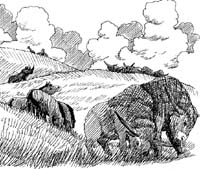
Grasses Support Grazing Animals
The plants of the Tertiary are very similar to the plants that we have today. The warm
climate at the beginning of the period favored dense forests. As the
climate cooled open woodlands and grasslands became abundant. The
grasses were important because they supported huge herds of grazing
animals.
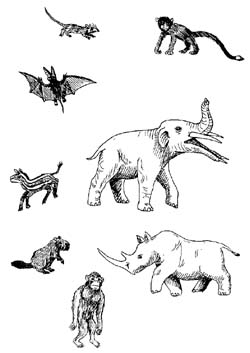
The Rise of The Mammals
The extinction event at the close
of the Cretaceous Period wiped out the dinosaurs, large reptiles, and
many other species. This left room for new animals to develop. The mammals became the dominant animals. In fact, the Cenozoic Era is often called the Age of Mammals.
Most of the main groups of mammals were present by the Eocene Epoch.
With the dinosaurs and other large reptiles gone mammals grew in size,
numbers and diversity. They filled ecological niches in the sea on land
and in the air. The table above shows what mammals came on the scene
with each new epoch.
Hominids: Human Ancestors
During the Pliocene the first hominids appeared; these were our human ancestors!
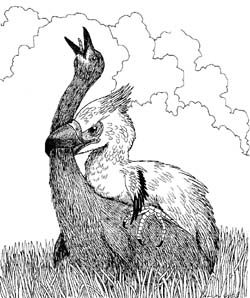
The Tertiary Was For The Birds
Birds
did almost as well as mammals during the Tertiary Period. Many of the
birds we know today were present. There were also many large flightless
birds that are now extinct. These birds did particularly well before the
mammals developed so many species.
Boney Fish and Sharks Develop New Species
Fish species branched out during the Tertiary Period. Sharks became more plentiful. Trout and bass evolved.
Flowering Plants Means Nectar For Insects
The
insect population increased in the Tertiary Period. Bees and other
insects that lived on pollen and nectar of the flowering plants
prospered.
The Tertiary Period Ends With An Ice Age and Land Bridges
The
cooling climate of the Tertiary Period led to huge glaciers at the
poles. The mountains of the world were also covered by glaciers,
including the newly formed Himalayas and Alps. The huge amounts of water
locked up in the ice lowered the level of the sea and land bridges
appeared:
- Between Asia and North America
- Great Britain and Europe
- South East Asia and Borneo
This enabled migrations of both plants and animals across these land bridges.
The Tertiary period which had begun hot and humid, ended in a cold dry ice age.
The next period is The Quaternary Period
Before the Tertiary Period is the Cretaceous Period
Fossils from the Tertiary Period for sale at our sister site Fossilicious.com
Check out some of the Educational Materials for sale on our sister site fossilicious.com.

interested in more? If so, you may want to check out our other sites:
fossilicious.com - Our online fossil and mineral rock shop.
rocksandminerals4u.com - An educational site about rocks, minerals, and geology.
Geologic Time Geologic Time Line
Cenozoic Era
Quaternary
Neogene
Paleogene
Mesozoic Era
Cretaceous
Jurassic
Triassic
Paleozoic Era
Permian
Carboniferous
Devonian
Silurian
Ordovician
Cambrian
Archean Time
Hadean Time
Teachers Resources
Activities for Education and Fun
Earth Science Lesson Plans
Activities For Kids
Fossil Lesson Plans
Fossil Activities
Education Articles
Coloring Pages
Dinosaur Coloring Pages
Montessori Materials
Geology Club
Fossil Hunting
 |
 |
 |
